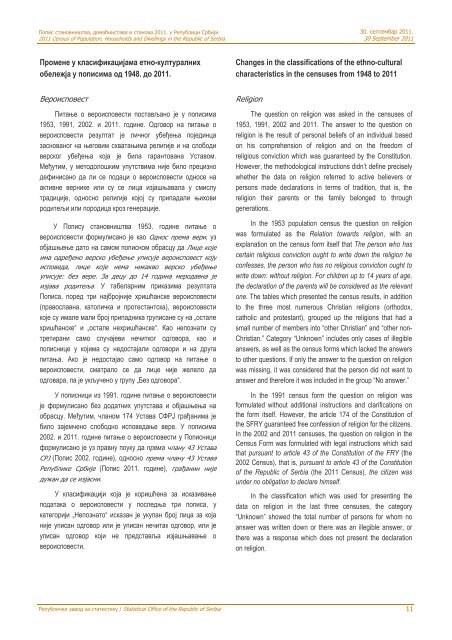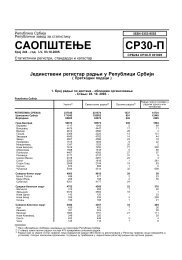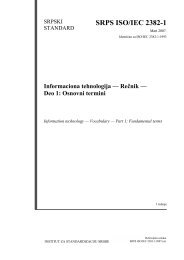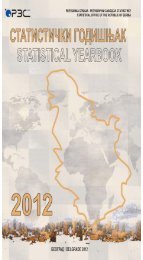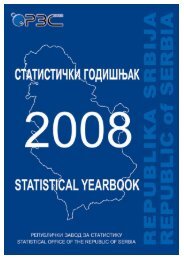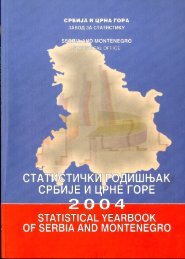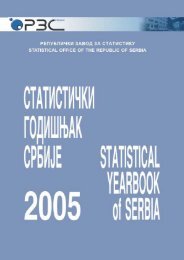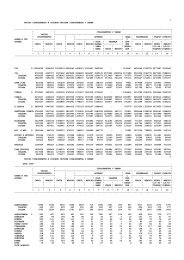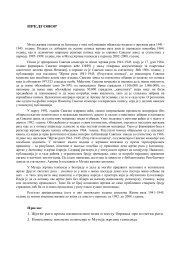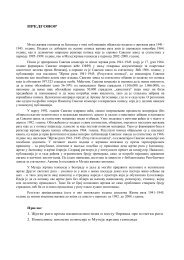Попис становништва, домаћинстава и станова 2011. у Републици Србији2011 Census of Population, Households <strong>and</strong> Dwellings in the Republic of Serbia30. септембар 2011.30 September 2011Промене у класификацијама етно-културалнихобележја у пописима од 1948. до 2011.Changes in the classifications of the ethno-culturalcharacteristics in the censuses from 1948 to 2011ВероисповестПитање о вероисповести постављано је у пописима1953, 1991, 2002. и 2011. године. Одговор на питање овероисповести резултат је личног убеђења појединца<strong>за</strong>снованог на његовим схватањима религије и на слободиверског убеђења која је била гарантована Уставом.Међутим, у методолошким упутствима није било прецизнодефинисано да ли се подаци о вероисповести односе наактивне вернике или су се лица изјашњавала у смислутрадиције, односно религије којој су припадали њиховиродитељи или породица кроз генерације.У Попису становништва 1953. године питање овероисповести формулисано је као Однос према вери, узобјашњење дато на самом пописном обрасцу да Лице којеима одређено верско убеђење уписује вероисповест којуисповеда, лице које нема никакво верско убеђењеуписује: без вере. За децу до 14 година меродавна јеизјава родитеља. У табеларним приказима резултатаПописа, поред три најбројније хришћанске вероисповести(православна, католичка и протестантска), вероисповестикоје су имале мали број припадника груписане су на „осталехришћанске“ и „остале нехришћанске“. Као непознати сутретирани само случајеви нечитког одговора, као ипописнице у којима су недостајали одговори и на другапитања. Ако је недостајао само одговор на питање овероисповести, сматрало се да лице није желело даодговара, па је укључено у групу „Без одговора“.У пописници из 1991. године питање о вероисповестије формулисано без додатних упутстава и објашњења наобрасцу. Међутим, чланом 174 Устава СФРЈ грађанима јебило <strong>за</strong>јемчено слободно исповедање вере. У пописима2002. и 2011. године питање о вероисповести у Пописнициформулисано је уз правну поуку да према члану 43 УставаСРЈ (Попис 2002. године), односно према члану 43 УставаРепублике Србије (Попис 2011. године), грађанин ниједужан да се изјасни.У класификацији која је коришћена <strong>за</strong> исказивањеподатака о вероисповести у последња три пописа, укатегорији „Непознато“ иска<strong>за</strong>н је укупан број лица <strong>за</strong> којаније уписан одговор или је уписан нечитак одговор, или јеуписан одговор који не представља изјашњавање овероисповести.ReligionThe question on <strong>religion</strong> was asked in the censuses of1953, 1991, 2002 <strong>and</strong> 2011. The answer to the question on<strong>religion</strong> is the result of personal beliefs of an individual basedon his comprehension of <strong>religion</strong> <strong>and</strong> on the freedom ofreligious conviction which was guaranteed by the Constitution.However, the methodological instructions didn’t define preciselywhether the data on <strong>religion</strong> referred to active believers orpersons made declarations in terms of tradition, that is, the<strong>religion</strong> their parents or the family belonged to throughgenerations.In the 1953 population census the question on <strong>religion</strong>was formulated as the Relation towards <strong>religion</strong>, with anexplanation on the census form itself that The person who hascertain religious conviction ought to write down the <strong>religion</strong> heconfesses, the person who has no religious conviction ought towrite down: without <strong>religion</strong>. For children up to 14 years of age,the declaration of the parents will be considered as the relevantone. The tables which presented the census results, in additionto the three most numerous Christian <strong>religion</strong>s (orthodox,catholic <strong>and</strong> protestant), grouped up the <strong>religion</strong>s that had asmall number of members into “other Christian” <strong>and</strong> “other non-Christian.” Category “Unknown” includes only cases of illegibleanswers, as well as the census forms which lacked the answersto other questions. If only the answer to the question on <strong>religion</strong>was missing, it was considered that the person did not want toanswer <strong>and</strong> therefore it was included in the group “No answer.”In the 1991 census form the question on <strong>religion</strong> wasformulated without additional instructions <strong>and</strong> clarifications onthe form itself. However, the article 174 of the Constitution ofthe SFRY guaranteed free confession of <strong>religion</strong> for the citizens.In the 2002 <strong>and</strong> 2011 censuses, the question on <strong>religion</strong> in theCensus Form was formulated with legal instructions which saidthat pursuant to article 43 of the Constitution of the FRY (the2002 Census), that is, pursuant to article 43 of the Constitutionof the Republic of Serbia (the 2011 Census), the citizen wasunder no obligation to declare himself.In the classification which was used for presenting thedata on <strong>religion</strong> in the last three censuses, the category“Unknown” showed the total number of persons for whom noanswer was written down or there was an illegible answer, orthere was a response which does not present the declarationon <strong>religion</strong>.<strong>Републички</strong> <strong><strong>за</strong>вод</strong> <strong>за</strong> статистику / Statistical Office of the Republic of Serbia 11
30. септембар 2011.30 September 2011Попис становништва, домаћинстава и станова 2011. у Републици Србији2011 Census of Population, Households <strong>and</strong> Dwellings in the Republic of SerbiaКласификација вероисповести у пописима 1953, 1991, 2002. и 2011.1953 1991 2002 2011 2)ХришћанскаПравославна Православна Православна ПравославнаРимокатоличка Католичка Католичка КатоличкаПротестантска Протестантска Протестантска ПротестантскаОстале хришћанске вероисповестиПрипадници исламске верске<strong>за</strong>једницеИсламска Исламска ИсламскаМојсијева Јудаистичка Јудаистичка ЈудаистичкаОстале нехришћанскеНеопредељен, индиферентан, верујеПрооријентални култовиПрипада вероисповести која нијенаведенаВерник је, али не припада ниједнојвероисповестиПрооријентални култовиПрипада вероисповести која нијенаведенаВерник је, али не припада ниједнојвероисповестиОстале хришћанскеИсточњачке религијеОстале вероисповестиАгностикБез вере Није верник Није верник Није верник (атеиста)Без одговораНије се изјаснио према члану 43Устава СРЈНије се изјаснио према члану 43Устава РСНепознато Непознато Непознато НепознатоClassification of <strong>religion</strong> in the censuses of 1953, 1991, 2002 <strong>and</strong> 20111953 1991 2002 2011 2)ChristianOrthodox Orthodox Orthodox OrthodoxRoman Catholic Catholic Catholic CatholicProtestant Protestant Protestant ProtestantOther Christian <strong>religion</strong>sOther ChristianMembers of the Islamic religiouscommunityIslam Islam IslamMoses’ Judaism Judaism JudaismEastern <strong>religion</strong>sPro-oriental cultsPro-oriental cultsOther non-Christian Belongs to <strong>religion</strong> not stated earlier Belongs to <strong>religion</strong> not stated earlier Other <strong>religion</strong>sUndefined, indifferent, believesBeliever, but does not belong to any <strong>religion</strong> Believer, but does not belong to any<strong>religion</strong>AgnosticNo <strong>religion</strong> Not a believer Not a believer Not a believer (atheist)Did not declare pursuant to article 43 of Did not declare pursuant to article 43 ofNo answerthe Constitution of the FRYthe Constitution of the RSUnknown Unknown Unknown Unknown2)Класификација вероисповести према којој су иска<strong>за</strong>ни подаци Пописа 2011. годинепрати Препоруке Конференције европских статистичара <strong>за</strong> пописе становништва истанова око 2010. године.2)Classification of <strong>religion</strong>s used for presenting the data from the 2011 census follows theConference of European Statisticians Recommendations for the 2010 Censuses ofPopulation <strong>and</strong> HousingУ табели А1 прика<strong>за</strong>н је упоредни прегледстановништва према вероисповести по пописима 1953,1991, 2002. и 2011. године, према класификацији која јепримењена у Попису 2011. године.Напомена: Подаци пописа пре 1991. године односе сена читаву територију Републике Србије, док пописи 1991,2002. и 2011. године не садрже податке <strong>за</strong> АП Косово иМетохија. Наиме, Попис 1991. године бојкотован је одстране већине албанског становништва, док 2002. и 2011.године на територији јужне српске покрајине нису постојалиуслови <strong>за</strong> спровођење пописа.12Table А1 shows a comparative overview of the populationby <strong>religion</strong> according to the censuses of 1953, 1991, 2002 <strong>and</strong>2011, in line with the classification applied in the 2011 Census.Remark: The census data before 1991 refer to the wholeterritory of the Republic of Serbia, while the 1991, 2002 <strong>and</strong>2011 censuses do not contain the data for the AP Kosovo <strong>and</strong>Metohia. Namely, the 1991 Census was boycotted by themajority Albanian population, while in 2002 <strong>and</strong> 2011 therewere no conditions on the territory of the south Serbian provincefor the implementation of the census.<strong>Републички</strong> <strong><strong>за</strong>вод</strong> <strong>за</strong> статистику / Statistical Office of the Republic of Serbia
- Page 2 and 3: Република СрбијаРе
- Page 4 and 5: Попис становништва
- Page 6 and 7: Попис становништва
- Page 8 and 9: Попис становништва
- Page 10 and 11: Попис становништва
- Page 14 and 15: Попис становништва
- Page 16 and 17: Попис становништва
- Page 18 and 19: Попис становништва
- Page 20 and 21: Попис становништва
- Page 22 and 23: Попис становништва
- Page 24 and 25: Попис становништва
- Page 26 and 27: Попис становништва
- Page 28 and 29: Попис становништва
- Page 30 and 31: Попис становништва
- Page 32 and 33: Попис становништва
- Page 34 and 35: Попис становништва
- Page 36 and 37: Попис становништва
- Page 38 and 39: Попис становништва
- Page 40 and 41: Попис становништва
- Page 42 and 43: Попис становништва
- Page 44 and 45: Попис становништва
- Page 46 and 47: Попис становништва
- Page 48 and 49: Попис становништва
- Page 50 and 51: Попис становништва
- Page 52 and 53: Попис становништва
- Page 54 and 55: Попис становништва
- Page 56 and 57: Попис становништва
- Page 58 and 59: Попис становништва
- Page 60 and 61: Попис становништва
- Page 62 and 63:
Попис становништва
- Page 64 and 65:
Попис становништва
- Page 66 and 67:
Попис становништва
- Page 68 and 69:
Попис становништва
- Page 70 and 71:
Попис становништва
- Page 72 and 73:
Попис становништва
- Page 74 and 75:
Попис становништва
- Page 76 and 77:
Попис становништва
- Page 78 and 79:
Попис становништва
- Page 80 and 81:
Попис становништва
- Page 82 and 83:
Попис становништва
- Page 84 and 85:
Попис становништва
- Page 86 and 87:
Попис становништва
- Page 88 and 89:
Попис становништва
- Page 90 and 91:
Попис становништва
- Page 92 and 93:
Попис становништва
- Page 94 and 95:
Попис становништва
- Page 96 and 97:
Попис становништва
- Page 98 and 99:
Попис становништва
- Page 100 and 101:
Попис становништва
- Page 102 and 103:
Попис становништва
- Page 104 and 105:
Попис становништва
- Page 106 and 107:
Попис становништва
- Page 108 and 109:
Попис становништва
- Page 110 and 111:
Попис становништва
- Page 112 and 113:
Попис становништва
- Page 114 and 115:
Попис становништва
- Page 116 and 117:
Попис становништва
- Page 118 and 119:
Попис становништва
- Page 120 and 121:
Попис становништва
- Page 122 and 123:
Попис становништва
- Page 124 and 125:
Попис становништва
- Page 126 and 127:
Попис становништва
- Page 128 and 129:
Попис становништва
- Page 130 and 131:
Попис становништва
- Page 132 and 133:
Попис становништва
- Page 134 and 135:
Попис становништва
- Page 136 and 137:
Попис становништва
- Page 138 and 139:
Попис становништва
- Page 140 and 141:
Попис становништва
- Page 142 and 143:
Попис становништва
- Page 144 and 145:
Попис становништва
- Page 146 and 147:
Попис становништва
- Page 148 and 149:
Попис становништва
- Page 150 and 151:
Попис становништва
- Page 152 and 153:
Попис становништва
- Page 154 and 155:
Попис становништва
- Page 156 and 157:
Попис становништва
- Page 158 and 159:
Попис становништва
- Page 160 and 161:
Попис становништва
- Page 162 and 163:
Попис становништва
- Page 164 and 165:
Попис становништва
- Page 166 and 167:
Попис становништва
- Page 168 and 169:
Попис становништва
- Page 170 and 171:
Попис становништва
- Page 172 and 173:
Попис становништва
- Page 174 and 175:
Попис становништва
- Page 176 and 177:
Попис становништва
- Page 178 and 179:
Попис становништва
- Page 180 and 181:
Попис становништва
- Page 182 and 183:
Попис становништва
- Page 184 and 185:
Попис становништва
- Page 186 and 187:
Попис становништва
- Page 188 and 189:
Попис становништва
- Page 190 and 191:
Попис становништва
- Page 192 and 193:
Попис становништва
- Page 194 and 195:
Попис становништва
- Page 196 and 197:
Попис становништва
- Page 198 and 199:
Попис становништва
- Page 200 and 201:
Попис становништва
- Page 202 and 203:
Попис становништва
- Page 204 and 205:
Попис становништва
- Page 206 and 207:
Попис становништва
- Page 208 and 209:
Попис становништва
- Page 210 and 211:
Попис становништва
- Page 212 and 213:
Попис становништва
- Page 214 and 215:
Попис становништва
- Page 216 and 217:
Попис становништва
- Page 218 and 219:
Попис становништва
- Page 220 and 221:
Попис становништва
- Page 222 and 223:
Попис становништва
- Page 224 and 225:
Попис становништва
- Page 226 and 227:
Попис становништва
- Page 228 and 229:
Попис становништва
- Page 230 and 231:
Попис становништва
- Page 232 and 233:
Попис становништва
- Page 234 and 235:
Попис становништва
- Page 236 and 237:
Попис становништва
- Page 238 and 239:
Попис становништва
- Page 240 and 241:
Попис становништва
- Page 242 and 243:
Попис становништва
- Page 244 and 245:
Попис становништва
- Page 246 and 247:
Попис становништва
- Page 248 and 249:
Попис становништва
- Page 250 and 251:
Попис становништва
- Page 252 and 253:
Попис становништва
- Page 254 and 255:
Попис становништва
- Page 256 and 257:
Попис становништва
- Page 258 and 259:
Попис становништва
- Page 260 and 261:
Попис становништва
- Page 262 and 263:
Попис становништва
- Page 264 and 265:
Попис становништва
- Page 266 and 267:
Попис становништва
- Page 268 and 269:
Попис становништва
- Page 270 and 271:
Попис становништва
- Page 272 and 273:
Попис становништва
- Page 274 and 275:
Попис становништва
- Page 276 and 277:
Попис становништва
- Page 278 and 279:
Попис становништва
- Page 280 and 281:
Попис становништва
- Page 282 and 283:
Попис становништва
- Page 284 and 285:
Попис становништва
- Page 286 and 287:
Подаци из овог обра
- Page 288 and 289:
27.ГДЕ ЛИЦЕ ПОХАЂА Ш
- Page 290 and 291:
Подаци из овог обра
- Page 292 and 293:
Сродство с лицем на
- Page 302:
ВЕРОИСПОВЕСТ, МАТЕ


